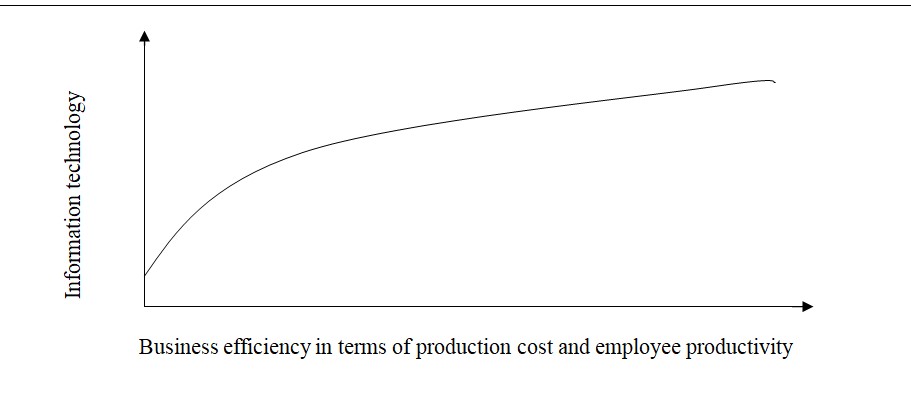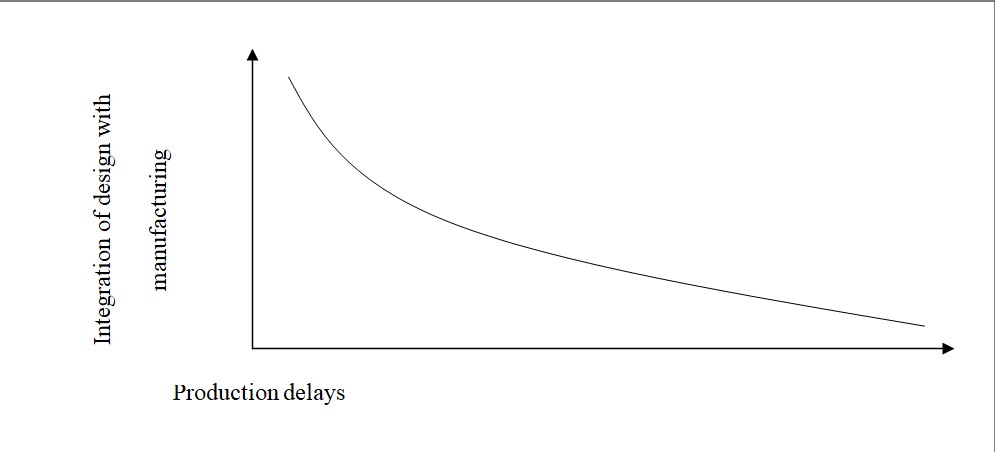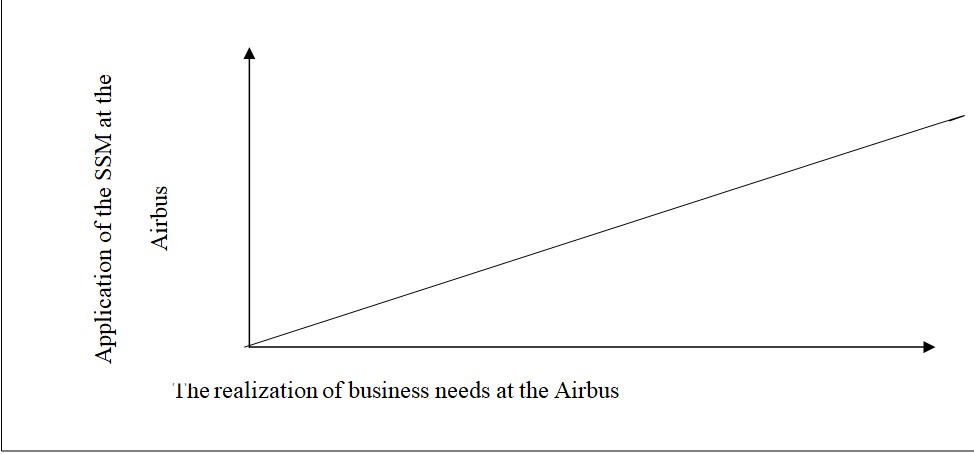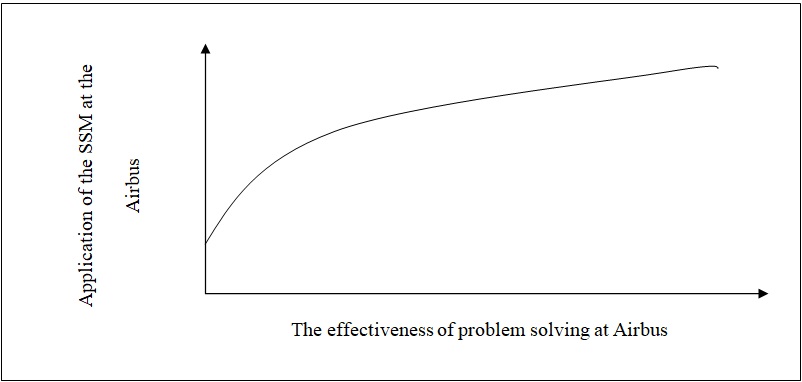Systems and operations management is primarily concerned with ensuring that the execution of business operations of an organisation are in an efficient manner, using minimal resources in order to facilitate the realisation of business requirement. Typically, it is an example of a management strategy that aims at the conversion of the business resources into profitable outputs with the aim of customer satisfaction (Ahmed 2009). In the context of the Airbus and its integration within business, systems and operations management is of significant importance in diverse ways. The following are some of the roles of the systems and operations management in the Airbus.
The development of a new ideology requires effective plan of approach from the design phase all the way up to the implementation phase (Aswathappa 2005). The development of the Airbus required such a plan of approach in ensuring that it remains operational in an effective manner that does not put the lives of the passengers at risk. The first element of systems and operations management that are beneficial to the airbus is the concept of Management control and coordination. This aims at ensuring the realisation of organisational goals in an efficient and timely fashion, without jeopardizing the overall organisational operations (Checkland & Poulter 2006). One of the most evident problems that faced the Airbus is increasing delays during the launch of the Airbus.
The Airbus suffers significant production delays, which are evident by factors such as delivery delays, lack of proper plan of implementation that results into deviation from the original plan of developing large aircrafts and finally launching delay that lasted for approximately a whole year. This resulted to customer dissatisfaction, this is possibly due to ineffective systems and operations management practices. Management coordination and control aims at ensuring there is a systematic methodology towards what the organisation wants to develop (Aswathappa 2005). It is a vital component of planning phase, which the Airbus required in order to ensure that the development of their aircraft was successful. Management control and coordination entails the deployment of the various administrative controls and evaluations before a major decision is made at the organisational level (Aswathappa 2005).
The second role of the systems and operations management within the Airbus is to ensure that there is flexibility in the execution of the business operations (Chase 2006, p. 58). This is important in reengineering the design of a product to suit the requirements of the clients of an organisation. Flexibility is imperative for business firms in evaluating the choice between the flexibility of the product and the volume of production (Brown & Blackmon 2001). With regard to this, the Airbus did not conduct an in depth needs analysis of its customer requirements before setting up a plan to construct a large aircraft, and then later deviate from the original plan to concentrate on the design of smaller jumbos. Systems and operations management ensures that an organisation deploys the concept of flexibility during the execution of business processes in order to accommodate future changes, without having the need to get back to the starting point (Chase 2006).
The third role of operations management at the Airbus is that it ensures the competitive advantage of the firm (Couprie 2007). Production delays and unrealized anticipations play a great deal in affecting the way potential customers perceive the effectiveness of a firm (Chase 2006). Therefore, the Airbus should deploy effective production control approaches in order to eliminate customer dissatisfaction that may be because of ineffective production methodologies. This means that the operations strategy is therefore a vital concept that the Airbus needs to put into consideration in order for the firm to enhance its competitiveness in the current Airlines market. Richard Chase, a prominent business literature author argues that operations management is an important concept that business enterprises should put into consideration when undertaking their daily business processes.
Integrating systems and operations management with the business plays a significant role in quality management, performance management and the formulation of organisational procedures and policies (Checkland & Poulter 2006). Therefore, systems and operations management, through fostering performance management plays a significant role in affecting the overall success of the organisation. Policies and procedures ensure that the execution of business processes is done in a manner that utilizes minimal resources to develop a product or an asset that is more profitable. The realisation of this is through a reduction of the overhead production costs (Couprie 2007).
How the Airbus information systems and operations management should be updated to support and improve their business efficiency
Information systems are an important aspect of the overall business structure (Ahmed 2009). This is because they provide avenues through which the various personnel in the firm can have access to information that is important in the daily running of the business. It is imperative for information systems of a given business enterprise to be up to date in order to function effectively in the current business environment. The Airline industry is one such example that requires an updated information system due to the dynamic nature of the customer base and the ever-changing customer requirements. The following section provides an outline of how the Airbus information should be updated in order to provide the required support and enhance overall business efficiency (Eisenhower 2009).
One of the significant strategies to update the Airbus information system is through using Information Technology (Ahmed 2009). Integrating IT with the business processes for the organisation is one of the most beneficial strategies that a firm can deploy in order to enhance employee productivity and facilitate the overall efficiency of the firm (Ahmed 2009). There are diverse advantages associated with the optimization of processing of flight data. This implies that aircraft manufactures and firms dealing with flight services have the need to adopt and integrate new generation computer technologies to facilitate in the control of the flight and the management of aeronautic data. The implementation of an effective aircraft information system is an important strategy in ensuring that the execution of the business processes by Airbus is effective (Chase 2006).
The integration of IT into the information systems and operations management will foster efficiency, provide the required support through enhancing the management of aircraft operations, and provide an avenue through which the firm can collect data related to aircrafts in digital form thereby facilitating easy data analysis procedures by the organisation (Graham 2008). In addition, deploying of new generation computer architectures will serve to create a platform through which the firm can automate its critical production processes, thereby reducing potential errors that may arise during aircraft manufacture (Checkland & Poulter 2006). The following graph illustrates how integrating IT with the business processes provides support and enhances efficiency.

Another strategy in updating the information system and management processes is to deploy the use of effective decision support systems (Pilikinton & Meredith 2009). Decision-making is an important aspect of the business firm, this implies that effective decision making approaches are therefore required in order to make the firm a success (Pilikinton & Meredith 2009). As a result, inclusion of decision support systems in the systems and operations management portfolio of the Airbus would serve to eliminate some of the risks associated with poor decision-making approaches in the firm.
Decision Support Systems can be implemented in the system using appropriate software applications, with the objective of the overall realisation of the firms goals, thereby increasing the efficiency of the firm and providing necessary support in the decision making process at the firm (Pilikinton & Meredith 2009). Alan Pilikinton and Jack Meredith, prominent business journal contributors contest that effective decision-making is a key success factor that a business enterprise must integrate with its operations (2009); this implies that the Airbus also needs to update implement effective decision-making procedures using Decision Support Systems in its information and systems management procedures (Chase 2006).
Another strategy that the Airbus can deploy in updating its information systems and operations management is through the integration of the design with the manufacturing process (Ahmed 2009). This aims at ensuring the elimination of fragmented structures in the manufacturing processes at the Airbus; which ultimately results to elimination of manufacturing delays of aircrafts. Issues such as internal rivalries and the need to maintain a balance between its plants located in France and Germany should be dealt with in order for the systems and operations management to result in the firm’s efficiency and productivity (Robinson 2009). The Airbus should use the same design and software in the manufacture of its aircrafts in both the manufacturing plants located in France and Germany. The manufacturing process needs an update in manner that facilitates the streamlining of the design process with the manufacturing process through the elimination of temporary and inefficient manufacturing methodologies (Surhone & Timpledon 2009).
This serves to eliminate delays in the manufacture of the aircraft. It is imperative that the Airbus maintains a streamlined manufacturing process in order for the firm to turn out effective and maximize on key aspects such as productivity. According to design reports released by CNN travel, which is an independent broadcasting company owned by Time Warner media, which is a dubbed the 2010 Airline Quality Rating, one of the significant causes of delays in the manufacture of aircrafts by the airbus is a manufacturing process that lacks integration of the design with the manufacturing procedures (Manag 2010). Therefore, this strategy plays a significant role in the elimination of delays associated with aircraft manufacture (Manag 2010). The graph below depicts how integrating the design with the manufacturing process reduces production delays at the Airbus

Soft Systems Methodology in analysing and defining the business requirements of Airbus
The Soft Systems Methodology (SSM) approach is one of the effective approaches that the Airbus should deploy in order to tackle some of its problems in the design and manufacturing procedures (Chase 2006). Typically, the strategy aims to eliminate problems associated with cases that there was lack of definition of the problem. The SSM bases on the mental constructs to evaluate the human understanding and perception; this is important in the evaluation of the systems and operations management in a business enterprise. In this context, the organisation is a system with an underlying objective (Schweizer 2007).
The business requirements of the Airbus consist of two types: internally oriented and externally oriented. Internal business requirements include factors such as organisational efficiency, strong organisational culture, increased employee productivity, reduction in production costs and increase profitability (Naresh 2005). External business requirements includes the need to increase customer satisfaction, increase competitive advantage of the firm and increase the market share in the aircraft manufacture industry (Couprie 2007). The SSM provides a framework for analysis and use of informal definition of the business requirements for the firm through a series of steps outlined below.
The first strategy that the SSM deploys in the quest for analysis and definition of the business requirements of the Airbus is through organisational design (Couprie 2007). Organisational design is diverse and incorporates issues such as the establishment of organisational cultures based on the needs of the firm, reconsideration of the organisational roles and responsibilities of the various human resources at the firm and finally the redesigning of the overall organisational structure. Organisational design usually has an effect on the overall information systems and operations management in the sense it affects the way in which the business processes are executed at the organisational level (Harold & Heinz 2006). The relationship between the SSM and organizational design is shown in the diagram below.

The second application of the SSM in defining and analysing of the business requirements at the Airbus is through Information systems (Ahmed 2009). This typically entails the outlining of information needs of the firm, the establishment and development of Information System strategies. Information systems also serve to evaluate the impacts associated with computerization of the firm, such as the benefits associated with in terms of realization of the business requirements (Checkland & Poulter 2006). An important aspect of the information systems is that it facilitates the concept of knowledge acquisition, which plays a significant role during the analysis and definition of the business requirements for the firm (Ahmed 2009). An integration of the above entities of information systems plays a significant role in the definition and analysis of the business requirements for the Airbus.
The next application of the SSM in the analysis and definition of business requirements at the Airbus is through fostering general problem solving (Ahmed 2009). This primary entails having an understanding of the complex problem situations and their impacts if they are not addressed in an appropriate manner. Problem classification is also an important concept under this category that plays an important role in the definition and analysis of business needs of the firm (Naresh 2005). The graph below depicts the relationship that exists between problem solving and the application of the SSM

Another significant role of the SSM in the definition and analysis of business requirement is through providing a framework for performance evaluation (Ahmed 2009). Performance evaluation is a critical success factor that the Airbus should weigh to determine if it has realised its business goals and objectives. It usually entails the deployment of concepts such as performance indicators, focusing on quality assurance and the establishment of variables to monitor the organisation effectively (Oz 2008). There are miscellaneous strategies that the SSM deploys in order to facilitate the process of business needs analysis and definition, examples include the development of strategies that aim at effective project development, the use of effective risk management approaches, development of business strategies and educational strategies that are aimed at the definition of training needs (Moores 2009).
The SSM strategy plays a significant role in Information System analysis and design. Checkland Peter and Poulter John, prominent authors of business literature, deploy the SSM in the establishment of Information System strategy (2006, p. 56). In the same capacity, the use of SSM is significant in Information Requirements analysis. These two concepts are imperative in the analysis and definition of business requirements by the Airbus. In a broader perspective, the analysis and definition of business requirements at the Airbus is significantly determined by the SSM, through proving a framework that the Airbus can base on during the evaluation of the business requirements of the firm (Manag 2010).
Analysis of the people, technology and organisational issues involved in improving the operations at Airbus
The efficiency in carrying out operations at the Airbus depends on the people, technology and the organisational issues at the Airbus. The three variables are dependent on each other in order to facilitate the realisation of business needs of an organisation (Surhone & Timpledon 2009). People in an organisation represent the key driving force towards the execution of business processes. In the context of the Airbus, people are involved in almost every phase of production ranging from analysis of business needs, manufacturing phase, decision-making process and problem solving. It is evident that people in an organisation determine the trends that a firm follows an ultimately the efficiency of execution of business processes (Lowson 2002).
This implies that the Airbus needs to deploy effective people management approaches in order to foster organisational improvement. It is important to note that people in an organization are the most important asset and they are responsible for the transformation of a given set of inputs into meaningful outputs; this means that firms such as the Airbus realise their business goals and objectives through people (Mahadevan 2010). As a result, the operation management of people is imperative for a business firm, implying that leaders and managers of the Airbus should establish effective business models, coupled with effective organisational structures. The people at the Airbus should undertake their duties and responsibilities with a particular concern aimed at the realization of business goals and objectives (Brown 2005). This is only achievable using effective people management procedures. Therefore, people behaviour should be streamlined with the organisational processes in order to improve efficiency of the organisation (Hampton 2009).
Technology also plays a significant role in ensuring effective production process. The Airbus depends on technology to execute its manufacturing procedures (Chase 2006). Apart from facilitating production, technology facilitates organisational management using strategies such as information systems, which facilitate access and manipulation of information at the organisation. The Airbus should integrate technology in its operations in order to facilitate the process of manufacturing aircrafts and eliminate the increasing delays that have been witnessed in the firm during the production of the Airbus A380.
Appropriate technology serves to reduce the overhead costs associated with the manufacturing process (Hill 2000). A significant incident that happened during December 2004 at the Airbus due to inappropriate technology resulted into the budget skyrocketing from £ 1.45 million to £ 12 million (Ahmed 2009). It is evident that the application of technology plays a significant role in ensuring overall efficiency and productivity of the business firm through aiding in production process and the management procedures (Lewis 2003).
Organisational issues are diverse in nature and play a significant role in influencing the success of the firm. An important aspect of organisational issues is organisational politics (Chase 2006). Management politics significantly affect decision-making procedures and the execution of business processes (Checkland & Poulter 2006). The improvement of the Airbus depends on the levels at which the organisational politics affect the execution of operations at the firm. A notable case that caused production delays is internal rivalries between the manufacturing plant that is France and its counterpart in Germany (Brown 2005). Such rivalries are a hindrance to the success of operations at the company. A strong organisational culture is also a significant requirement for effective undertaking of the firm’s operations (Ahmed 2009). The Airbus should aim at streamlining the organisational culture with the current goals and objectives of the firm (Clarke 2001).
In conclusion, an integration of people, technology and streamlining organisational issues with the above plays an important role in ensuring the success of a business firm. Therefore, an effective strategic systems and operations management should put into consideration the above factors in order for strategic management for the organization of the business enterprise (Checkland 2000). This means that people, technology and organisational issues need to be streamlined in order for the execution of business processes to be efficient in terms of transforming the organizational resources into meaningful outputs.
References
Ahmed, A 2009, ‘Antecedents and Consequence of Strategic Manufacturing Effectiveness: A Conceptual Framework’, International Journal of Applied Operations Management, vol 1, no. 2, pp. 8-25.
Aswathappa, A 2005, International business, Tata McGraw-Hill, New Delhi.
Brown, S & Blackmon, K 2001, Operations management: policy, practice and performance improvement, Butterworth-Heinemann, London.
Brown, S 2005, Strategic operations management, Butterworth-Heinemann, London.
Chase, R 2006, Operations management for competitive advantage, Volume 2006, Part 2, McGraw-Hill/Irwin, New York.
Checkland, P & Poulter, J 2006, Learning for Action: A short definitive account of Soft Systems Methodology and its use for Practitioners, teachers and Students, Wiley, Chichester.
Checkland, P 2000, Soft systems methodology: a 30-year retrospective, Wiley, New York.
Clarke, S 2001, Information systems strategic management: an integrated approach, Routledge, New York.
Couprie, D 2007, Soft Systems Methodology, University of Calgary, Calgary.
Eisenhower, E 2009, ‘Dimensions of Global Operations Strategy In Service Business: A Value-Chain-Based Analysis’, International Journal of Applied Operations Management, pp. 25-45.
Graham, C 2008, Service operations management: improving service delivery, Financial Times/Prentice Hall, New York.
Hampton, J 2009, Fundamentals of enterprise risk management: how top companies assess risk, manage exposures, and seize opportunities, AMACOM Div American Mgmt Assn, New York.
Harold, K & Heinz, W 2006, Essentials Of Management, Tata McGraw-Hill, New Delhi.
Hill, T 2000, Manufacturing Strategy: Text and Cases, Irwin, Homewood, IL.
Lewis, MA 2003, ‘Analysing Organisational Competence: Implications for the Management of Operations’, International Journal of Operations and Production Management, vol 23, no. 7, p. 731–756.
Lowson, R 2002, Strategic operations management: the new competitive advantage, Routledge, New York.
Mahadevan, P 2010, Operations Management: Theory and Practice, Pearson Education India, New Delhi.
Manag, O 2010, ‘operations management’, Journal of Operations Management, pp. 89 123.
Moores, T 2009, ‘Cultural Problems in Applying SSM for IS Development’, Journal of Global Information Management, vol 8, no. 1, pp. 89-101.
Naresh, R 2005, A Modern Approach To Operations Management, New Age International, New Jersey.
Oz, E 2008, Management Information Systems, Cengage Learning, New York.
Pilikinton, A & Meredith, J 2009, ‘The Evolution of the Intellectual Structure of Operations Management’, Journal of Operations Management, vol 27, no. 3, pp. 185-202.
Robinson, P 2009, Operations Management in the Travel Industry, CABI, New Jersey.
Schweizer, M 2007, Operational and Strategic Decision-making: Soft Systems Methodology, Analytical Hierarchy Process and Alexandrian Pattern Analysis Applied, GRIN Verlag, Moscow.
Surhone, L & Timpledon, M 2009, oft Systems Methodology: Soft Systems Methodology, Business Process Modeling, Enterprise Modelling, Hard Systems, List of Thought Processes, Structured Systems Analysis and Design Method, Systems Thinking, Betascript Publishers, London.